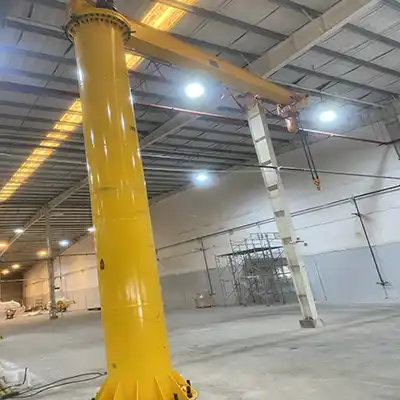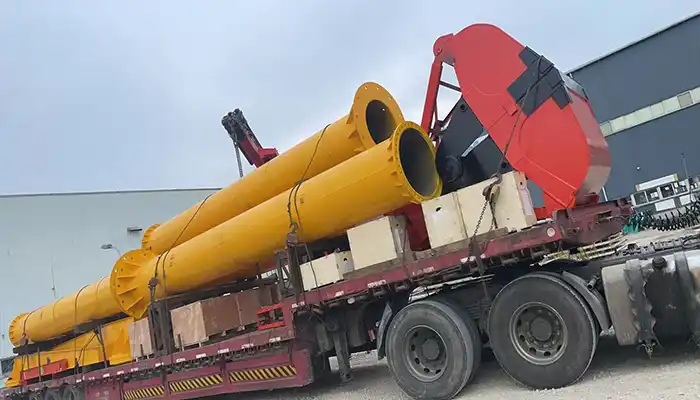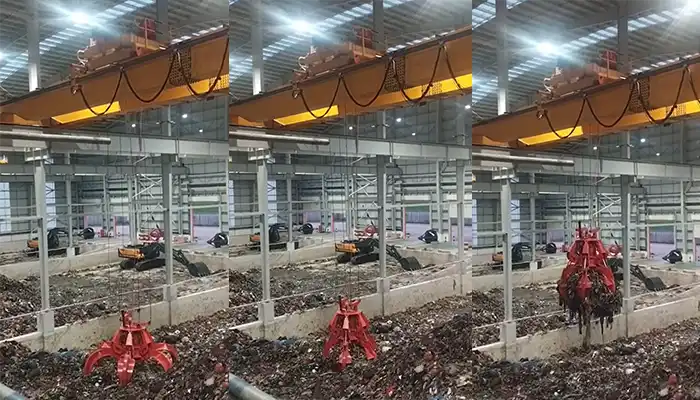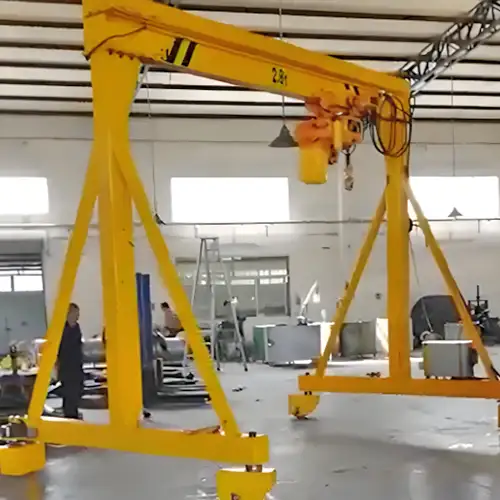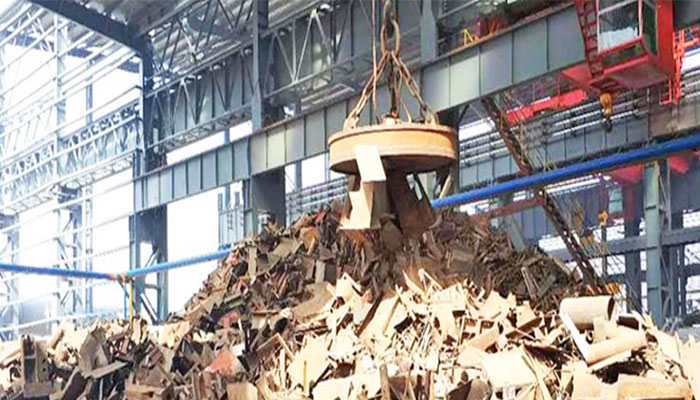
Pricing Guide: 15 Ton Electromagnetic Overhead Crane Cost
Explore factors affecting the price of a 15-ton electromagnetic crane, helping buyers estimate costs.Get your electromagnetic overhead crane.
What is an Electromagnetic Overhead Crane?
An electromagnetic overhead crane is a type of lifting equipment that uses a powerful electromagnet to lift and move metal objects. These cranes are commonly used in workshops or steel mills where heavy metal parts like billets, scrap metal, or coils need to be handled. The electromagnet can hold the metal objects securely, making it easy to move them around.
Why Pricing Information is Important for Buyers
When you're considering buying a 15-ton electromagnetic overhead crane, knowing the price is essential. Without understanding the cost, it’s hard to plan your budget effectively. Here’s why pricing matters:
- Helps set a realistic budget: Understanding the price allows you to determine if the crane fits within your financial plan.
- Prevents surprises: Knowing what to expect in terms of cost can help avoid unexpected expenses.
- Makes comparison easier: You can compare different suppliers and models more effectively if you have an idea of price ranges.
The main goal of this guide is to give you a clear understanding of how much a 15-ton electromagnetic overhead crane might cost. We'll cover the factors that affect the price and provide you with a breakdown of what you can expect to pay for a crane, from basic models to premium ones. This guide will help you make an informed decision when it comes time to purchase, so you can choose the right crane without going over budget.
Factors Influencing the Price of a 15-Ton Electromagnetic Overhead Crane
Crane Design and Specifications
The design and specifications of the crane are key factors in determining its cost. Here’s what you need to know:
Single vs. Double Girder Design
- Single girder cranes are typically more affordable and suitable for lighter, medium-duty tasks.
- Double girder cranes offer greater stability and lifting capacity, making them more expensive but ideal for heavy-duty operations.
Span Length and Lifting Height
- The span (distance between the crane supports) and lifting height affect both the complexity and cost of the crane.
- Shorter spans and lower lifting heights cost less, while longer spans and higher lifting heights require more materials and engineering, thus increasing the price.
Customization Options
- Custom features like remote control systems, specific lifting speeds, and enhanced safety mechanisms can raise the price. These options are tailored to your specific needs and operations, adding both value and cost.
Material and Build Quality
The materials used in the crane's construction and its overall build quality are crucial in determining both performance and price. Consider the following:
Type of Steel Used
- Cranes are typically made from various grades of steel. The quality of steel impacts both the price and durability of the crane.
- Standard steel is more affordable but may wear out more quickly.
- High-quality steel, like alloy steel, increases the initial cost but offers greater durability and longer lifespan.
Durability and Corrosion Resistance
- Cranes that operate in harsh environments (such as high moisture or outdoor areas) need to be built to withstand rust and corrosion.
- Cranes with corrosion-resistant coatings or special materials add to the upfront cost but are essential for long-term reliability, reducing the need for frequent maintenance or replacements.
Electromagnetic Technology
The type of electromagnetic lifting system used and the features it offers can significantly influence the price:
- Type of Electromagnetic Lifting System
There are different types of electromagnetic systems that vary in complexity and performance. The more advanced systems tend to be more expensive. Basic electromagnetic systems offer reliable lifting power, while more sophisticated ones come with features like automatic activation, adjustable magnet strength, and enhanced control systems. - Electromagnet Strength and Features
The strength of the electromagnet plays a big role in determining how much weight it can safely lift. A stronger electromagnet means the crane can lift heavier loads, but it also drives up the price. Additional features, such as magnet cooling systems, overload protection, or variable magnet strength for different types of metal, can also increase the cost.
Manufacturing Location
Where the crane is made can have a notable impact on its price:
Price Differences Based on Region
- Cranes made in China are often more affordable due to lower labor and material costs. Chinese manufacturers also offer a wide range of options with varying levels of customization.
- Cranes made in other countries, especially in regions like Europe or North America, may cost more due to higher labor costs, stricter regulations, and potentially more advanced technology.
- While the lower price of Chinese-made cranes can be appealing, you should consider factors like quality control, delivery times, and after-sales support.
Brand Reputation and Certifications
The brand and its certifications can also influence the price of a 15-ton electromagnetic overhead crane:
- Impact of Brand Quality
Well-established brands often offer higher-quality cranes that are more reliable, durable, and come with better customer service. These premium brands may come with a higher price tag but provide peace of mind when it comes to performance and after-sales support. - Certifications (e.g., CE, ISO)
Cranes that have CE (European Conformity) or ISO (International Organization for Standardization) certifications tend to cost more. These certifications ensure that the crane meets certain quality, safety, and environmental standards. However, they are an investment in safety and longevity, especially for businesses that prioritize high-quality standards.
Additional Features
Beyond the basic functionality, various added features can raise the cost of the crane:
- Remote Control Systems
Many modern cranes come with remote control systems that allow operators to control the crane from a distance. While this adds convenience and safety, it also increases the price. - Safety Features
Cranes with advanced safety systems, such as anti-collision technology, load monitoring systems, and overload protection, are usually more expensive. These features are designed to minimize accidents and downtime, offering long-term savings and peace of mind for the operator.
Each of these features can be customized to meet the needs of your specific operation, but it’s important to balance functionality with cost to ensure you’re getting the best value for your investment.
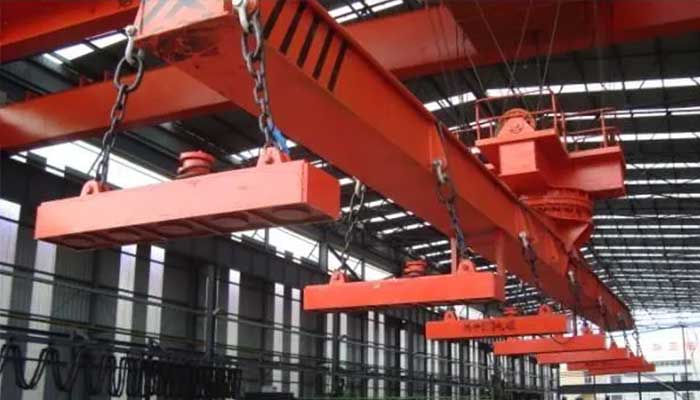
Electromagnetic overhead crane with electrical magnetic beam spreader
Cost Breakdown
Base Price of a 15-Ton Electromagnetic Overhead Crane
The base price of a 15-ton electromagnetic overhead crane can vary greatly depending on several factors. Generally, the price range for these cranes is as follows:
Low-End Options
- These cranes are typically simpler models with basic features and a single girder design. They may have fewer customization options and are made with standard materials.
- Price range: Around $20,000 to $30,000.
- Suitable for light to moderate-duty applications and basic lifting tasks.
Mid-Range Options
- These cranes have more advanced features, such as double girder design, higher-quality materials, and better safety features. They can handle more complex tasks with a moderate level of customization.
- Price range: Around $30,000 to $50,000.
- Ideal for medium-duty applications that require consistent performance and a longer lifespan.
High-End Options
- High-end cranes come with premium features such as advanced electromagnet systems, heavy-duty construction, and remote control capabilities. They are designed for heavy-duty, high-performance operations and come with a variety of safety and operational enhancements.
- Price range: Around $50,000 to $70,000+.
- These are typically used in large-scale operations, such as steel mills or foundries, where high reliability and performance are crucial.
Additional Costs
In addition to the base price, there are other costs to consider:
Installation and Setup
- Installation costs can vary depending on the complexity of the crane system, the location, and whether it’s a standard or customized installation.
- Price range: Around $5,000 to $15,000. This can be higher if significant modifications to the facility are required or if the crane needs specialized support structures.
Shipping and Delivery Fees
- Shipping costs depend on the distance from the manufacturer to your location, as well as the size and weight of the crane. For international shipping, customs fees and import taxes may apply.
- Price range: Typically, shipping fees can range from $2,000 to $10,000, depending on the location.
Maintenance and Spare Parts
- Over time, cranes need regular maintenance to ensure smooth operation and prevent breakdowns. The cost of spare parts (e.g., electromagnets, control systems, etc.) should also be factored in.
- Price range: Routine maintenance could cost anywhere from $1,000 to $5,000 annually, depending on usage, and spare parts costs can vary widely depending on the specific components that need replacing.
Customization and Optional Upgrades
Customization options and upgrades can significantly impact the overall price. Here are some examples:
Custom Features
- Features like remote control systems, variable lifting speeds, or adjustable electromagnet strength allow you to tailor the crane to your specific needs.
- Price impact: Customization can increase the price by 10% to 30% depending on the complexity and the specific features selected.
Extended Warranties
- Many manufacturers offer extended warranties that provide coverage beyond the standard warranty period. This is especially important for businesses that want to ensure long-term protection against mechanical failures.
- Price range: Extended warranties can cost $2,000 to $8,000 depending on the length of coverage and the level of protection offered.
Remote Controls and Safety Upgrades
- Adding a remote control system for ease of operation or additional safety features (such as anti-collision systems or overload protection) can increase the crane's cost.
- Price range: These features can add an extra $3,000 to $10,000 to the price, depending on the complexity and number of features included.
These additional costs and custom upgrades can quickly add up, so it’s important to carefully consider your needs and budget when making a decision. While it’s tempting to go for the most advanced features, finding the right balance between functionality and cost is key to getting the best value.
Typical Price Ranges
Understanding the different price ranges for a 15-ton electromagnetic overhead crane can help you make a more informed decision based on your needs and budget. Here’s a breakdown of the typical price ranges for these cranes:
Entry-Level Range: Basic Models with Minimal Customization
Price Range: Around $20,000 to $30,000
Features:
- Single girder design for simpler lifting tasks.
- Basic electromagnetic lifting systems with standard performance.
- Minimal customization options—ideal for basic, light-duty operations.
- Usually made with standard steel and have basic safety features.
These entry-level cranes are suitable for businesses with lighter material handling needs or those just starting to work with electromagnetic cranes. They offer reliable functionality at a more affordable price, though they may not have the same advanced features or long-term durability as higher-end models.
Mid-Range Options: Standard Quality with Moderate Customization
Price Range: Around $30,000 to $50,000
Features:
- Typically double girder design, offering better stability and heavier lifting capacity.
- Advanced electromagnetic systems with higher lifting strength and adjustable magnet options.
- Some customization options for span length, lifting height, and lifting speeds.
- Improved build quality with better materials, such as alloy steel for durability and corrosion resistance.
Mid-range cranes are ideal for medium-duty operations and those that need a balance between performance and cost. These cranes are often found in workshops or factories with moderate to heavy material handling requirements.
High-End Models: Premium Features, Top Brand Quality, Extensive Customization
Price Range: Around $50,000 to $70,000+
Features:
- Heavy-duty double girder design for the highest lifting capacities and stability.
- Premium electromagnetic lifting systems that can handle larger and more complex lifting tasks with features like variable magnet strength and automated systems.
- Extensive customization options, including remote control systems, advanced safety features, and high-tech control systems.
- Made with the best materials for durability, such as corrosion-resistant coatings, and designed for high-frequency use in demanding environments.
- Top brand quality with comprehensive warranties and exceptional after-sales service.
High-end models are typically used in large-scale operations, such as steel mills, foundries, and other heavy-duty industries, where reliability, performance, and safety are critical. While these cranes come with a higher price tag, they offer the best features and long-term durability.
Choosing the right crane depends on your specific needs, budget, and the intensity of your material handling tasks. By understanding these typical price ranges, you can better assess which option suits your operation while balancing costs and required functionality.
How to Get an Accurate Quote for Electromagnetic Overhead Cranes
When purchasing a 15-ton electromagnetic overhead crane, getting an accurate quote is essential to avoid unexpected costs. Here's how you can ensure that you receive an accurate and fair quote from manufacturers:
Importance of Providing Detailed Specifications
To get the most accurate quote, it’s crucial to provide detailed specifications. This helps the manufacturer understand your needs and offer a price that reflects the complexity and customization of the crane. Key specifications include:
- Lifting Capacity: Ensure that the crane’s lifting capacity matches your requirements (in this case, 15 tons).
- Design: Specify whether you need a single girder or double girder design.
- Span Length and Lifting Height: Be clear about the required span (distance between crane supports) and the lifting height.
- Electromagnetic System: Detail the type of electromagnetic system, including lifting strength and any special features like variable magnet strength or automatic systems.
- Customization Options: Mention if you need custom features such as remote controls, specific lifting speeds, or advanced safety features.
- Environmental Conditions: If your crane will be operating in harsh conditions (e.g., high humidity or exposure to corrosive materials), this will affect the materials and coatings needed, impacting the price.
The more information you provide upfront, the more accurately the supplier can estimate the price and prevent any surprises later.
Steps to Request a Quote from Manufacturers
Once you have your specifications in order, follow these steps to request a quote:
- Step 1: Research Manufacturers
Look for reputable manufacturers that specialize in electromagnetic overhead cranes. Consider manufacturers with experience in your industry and positive customer reviews. - Step 2: Provide Your Specifications
Reach out to manufacturers and provide them with your detailed crane specifications. Be clear about your budget, application, and any specific features you require. - Step 3: Request Multiple Quotes
To ensure you’re getting the best deal, request quotes from several manufacturers. This will give you a better sense of the market price and help you compare different options. - Step 4: Ask for a Breakdown
Request a breakdown of the quote, including the base price, additional costs for customization, installation, shipping, and maintenance. This will help you understand the total cost of ownership.
Questions to Ask the Supplier to Ensure Transparent Pricing
When communicating with suppliers, ask the following questions to ensure that you’re getting an accurate, transparent price:
- What’s included in the base price?
Ensure that the quote covers all the essential components, such as the crane structure, electromagnet, and control system. Ask for a detailed breakdown of what's included. - Are there any additional costs for customization?
If you're requesting custom features (e.g., remote control systems or enhanced safety features), ask for the exact cost of these upgrades. - What are the shipping and delivery fees?
Shipping costs can vary based on distance and crane size. Ask for an estimate of shipping fees and whether customs fees or taxes are included in the price. - What is the estimated installation cost?
Installation costs can vary, especially if modifications to your facility are required. Be sure to get an estimate for setup and installation services. - What warranties and after-sales support are included?
Ensure you understand the warranty period and the type of support provided after purchase, including maintenance and spare parts availability. - Can you provide references or case studies?
Request references or case studies from previous clients to gauge the supplier’s reliability and the quality of their cranes.
By asking these questions and providing detailed specifications, you can ensure that you receive a fair and accurate quote, allowing you to make a well-informed decision.
Tips for Buyers to Save on Costs
When buying a 15-ton electromagnetic overhead crane, it’s important to find ways to get the best value for your investment without compromising on quality. Here are some tips for buyers to save on costs:
Comparing Multiple Suppliers for Competitive Pricing
- Get quotes from several manufacturers to ensure you are getting a fair price. By comparing prices and features, you can make an informed decision based on the best balance between cost and quality.
- Look for reputable suppliers that offer reliable cranes at competitive prices. Don’t always settle for the first quote you receive—taking the time to research multiple options can help you find the best deal.
Considering Long-Term Maintenance and Operational Costs
- Factor in ongoing maintenance costs: While the initial price of the crane may be a significant investment, don’t forget to consider the long-term costs of upkeep and spare parts. A crane with higher-quality materials and design might cost more upfront but can save you money in the long run by reducing maintenance and downtime.
- Evaluate energy efficiency: Some cranes are designed to be more energy-efficient, which can reduce operating costs over time. An energy-efficient crane may have a higher price, but it can lead to savings on electricity bills in the long term.
- Plan for future spare parts: If possible, find out the cost of spare parts and whether the supplier offers long-term support. A lower initial cost might not be the best deal if the crane requires expensive parts or if the supplier’s support isn’t reliable.
Negotiating Discounts or Bulk Deals
- Ask for discounts: Don’t be afraid to negotiate. Suppliers may offer discounts for larger orders, repeat business, or even for offering a quick commitment. Sometimes, suppliers are willing to offer a better price to secure a deal, especially for large-scale or long-term customers.
- Consider bulk purchases: If you plan on purchasing additional cranes in the future, inquire about bulk pricing. Manufacturers may be willing to offer discounts if you order multiple cranes at once or sign a contract for future purchases.
Conclusion
The cost of a 15-ton electromagnetic overhead crane is influenced by a variety of factors, including:
- Design and specifications, such as single or double girder configurations, span length, and lifting height.
- Material quality and the type of steel used in construction, which affects durability and corrosion resistance.
- Electromagnetic technology, including the strength of the electromagnet and any advanced features.
- Brand reputation and certifications, with higher-quality brands and certified products typically costing more.
- Customization options that cater to specific needs but may add to the cost, like remote control systems or additional safety features.
Selecting the best 15-ton electromagnetic crane requires balancing your budget with the specific needs of your operation. Start by understanding what features are most critical for your tasks and how much you're willing to invest in customization, technology, and durability.
- If you’re on a tighter budget, consider an entry-level model with basic features, but make sure it fits your basic needs.
- For medium-duty operations, a mid-range option offers a good balance of quality, customization, and cost.
- For large-scale or high-demand applications, high-end models provide premium features and durability, justifying the higher price tag.
In the end, getting an accurate quote, comparing multiple suppliers, and considering both immediate and long-term costs will help you find the best crane at the right price.
